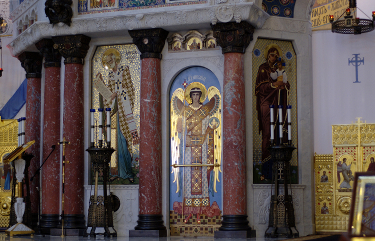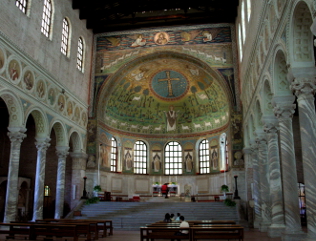Why Decorate a Christian Church?
by Philip Davydov with invaluable help of Rev. Fr. John Ball and Paul Stetsenko

We should first define the term �decoration�. Wikipedia lists it as, "Decoration is an object or act intended to increase the beauty of a person, room, etc." The Miriam-Webster Dictionary defines the word �decorate� as, "To make (something) more attractive; usually by putting something on it." Both of these definitions are correct.
But then why would we need to make our church building, (built as Home of God) more beautiful or even attractive?
For many years I have studied the role of images and other non-architectural components of the Christian church. In the course of my exploration, I have learned that these elements played a completely different role in medieval times than they do today.
If we try to analyze the medieval craftsmen�s' work and do our best to determine the main goal/purpose of their work, and that most definitely was not �decoration�.
From the very first centuries of the Christian church, all kinds of �motifs� painted in catacombs such as flowers, grapes, vine, and birds were intended to be very precise symbols transmitting a non-verbal message of martyrdom, salvation, paradise, but above all � the message about Christ.
 Commonly thought of as mere decoration of the catacombs, such paintings were in fact, recognizable visual symbols, called to attune the faithful to a certain state of mind and soul. In our understanding the purpose of these images cannot be identified as making the space attractive, rather their primary function was communicating through the brushstrokes the fiery faith of their creators.
Commonly thought of as mere decoration of the catacombs, such paintings were in fact, recognizable visual symbols, called to attune the faithful to a certain state of mind and soul. In our understanding the purpose of these images cannot be identified as making the space attractive, rather their primary function was communicating through the brushstrokes the fiery faith of their creators.
First terraneous Christian churches in some aspects are very similar to the catacomb cubicula. Buildings, nearly ugly outside, conceal interiors, illuminated with brilliant mosaics and precious stones. But if we analyze the imagery found in these first temples, (great number of them still persists in Italy, particularly in Rome and Ravenna), we may inevitably conclude that these images were governed by the same principles as the ones in the catacombs, - they were not made to embellish the walls, but to tell a story and inspire faith.
A beholder, contemplating these images, may experience the solemnity, grandeur and mightiness, but not enjoyment. They did not delight the view, but were made to seek a serious meditative dialogue, intense and honest.
Needless to say, these mosaics are far more complex and much more impactful than the frescoes of the catacomb Church; they also display much greater wealth, to say the least. Nevertheless, just like their antecedents, these images are visual sermons; one might say, they are inspiring, scintillating hymns proclaiming the Heavenly Kingdom. The faces of Christ, saints, and numerous biblical characters demonstrate that the medieval iconographers did their best to make images look realistic, but they avoided extra �polishing�.
 The images of angels and military men, Abraham and Sarah, and other figures were painted in an abbreviated way. They can be compared to sketches or quickly written notes and reminders which are valued not for the beauty of the handwriting but for the importance of the message. These characters are not beautiful people but extraordinary persons. So then we �read� these paintings in the same way we read the symbols in catacombs, and we are neither tempted to judge their artistic value nor estimate their monetary equivalent.
The images of angels and military men, Abraham and Sarah, and other figures were painted in an abbreviated way. They can be compared to sketches or quickly written notes and reminders which are valued not for the beauty of the handwriting but for the importance of the message. These characters are not beautiful people but extraordinary persons. So then we �read� these paintings in the same way we read the symbols in catacombs, and we are neither tempted to judge their artistic value nor estimate their monetary equivalent.
The history of the Christian visual sermon is almost as long as the Church history, but when we look through the centuries, we notice how seriously the visual language changed from year to year, from era to era, all throughout the church history. These changes were necessitated by practical considerations of everyday life, and our medieval colleagues could not have possible disregarded the needs of people around them.
 We look at the churches and icons, and see that solemnity and majesty of the first churches is shifting toward simplicity (typical of the iconoclast period) in 9th century, spiritual discipline in 12th, or the mystic tension of the 14th. These are, of course, just very general observations, and of course we should not forget about an unbelievable variety of other nuances and local traditions.
We look at the churches and icons, and see that solemnity and majesty of the first churches is shifting toward simplicity (typical of the iconoclast period) in 9th century, spiritual discipline in 12th, or the mystic tension of the 14th. These are, of course, just very general observations, and of course we should not forget about an unbelievable variety of other nuances and local traditions.
At this point, from my personal experience I would dare to suppose that in our days there are at least two ways to accept the very thought of this perpetual evolution and consider it to be natural.
The first way has been expressed often, and it usually goes along these lines:
Medieval iconographers and architects possessed great spiritual authority. They stood on the shoulders of the pioneers of the early Church, whose studies and experimentation had prepared the way for the medieval art to reach its peak in the 14th and 15th centuries. But since being humble enough we can't count ourselves to be deeply spiritual. In our time we should always consider icons, mosaics, frescoes and miniatures of these two centuries to be most worthy, i.e. canonical. It means for us that we can only copy their achievements without even a slightest thought of adding anything new. These principles guarantee our architecture and icons their canonicity, and only thus they can be accepted for the church use�.
 As for the second opinion, I can't prove I have heard it many times, but for me it also seems to be quite reasonable. After all, we cannot just dismiss the historical evidence of the perpetual evolution and development, - not just for the sake of the past but also for the sake of the future, in hope that the human life and the life of the Church goes on. This alternative view can be expressed like that:
As for the second opinion, I can't prove I have heard it many times, but for me it also seems to be quite reasonable. After all, we cannot just dismiss the historical evidence of the perpetual evolution and development, - not just for the sake of the past but also for the sake of the future, in hope that the human life and the life of the Church goes on. This alternative view can be expressed like that:
�Architecture, same as all the visual arts and crafts, being a natural part of everyday human life, was considered by the Christian church since the very first centuries to be rather ancillary instruments, mainly helping to convert fellow creatures to God. Professional succession and traditionalism helped these masters to find the main qualities, necessarily applicable to their work, but at the same time they were comparatively free to change to be up-to-date.
If we try to find any earliest statement, like the official acts of the Seventh Ecumenical Council (also known as the Second Council of Nicaea), we won't find any requirements for the technique or style of the images. The holy fathers did not speak about iconographic programs or architectural concepts. They only spoke about the power of the image, inspired by the Holy Spirit.
This, I think, might be the best answer to the question, whether we should decorate our churches, or not. From what we see and read, our predecessors never intended their church buildings or interiors to have a �complete look". Instead, they made every effort to influence the beholder with their faith through the images, first of all � through the choices they made in their works, choosing the truth but not necessarily beauty.
March-April 2014
